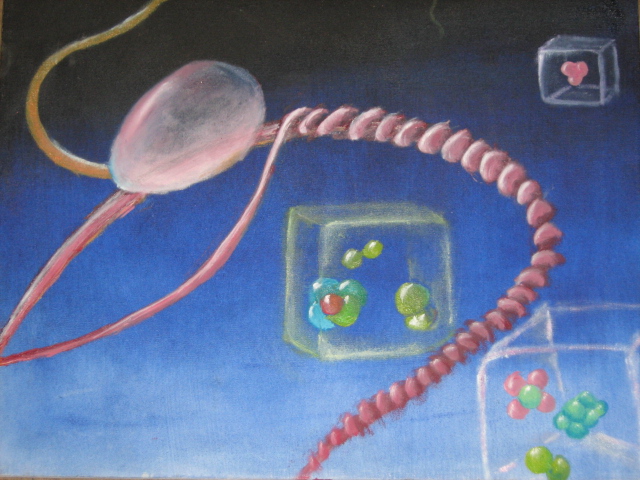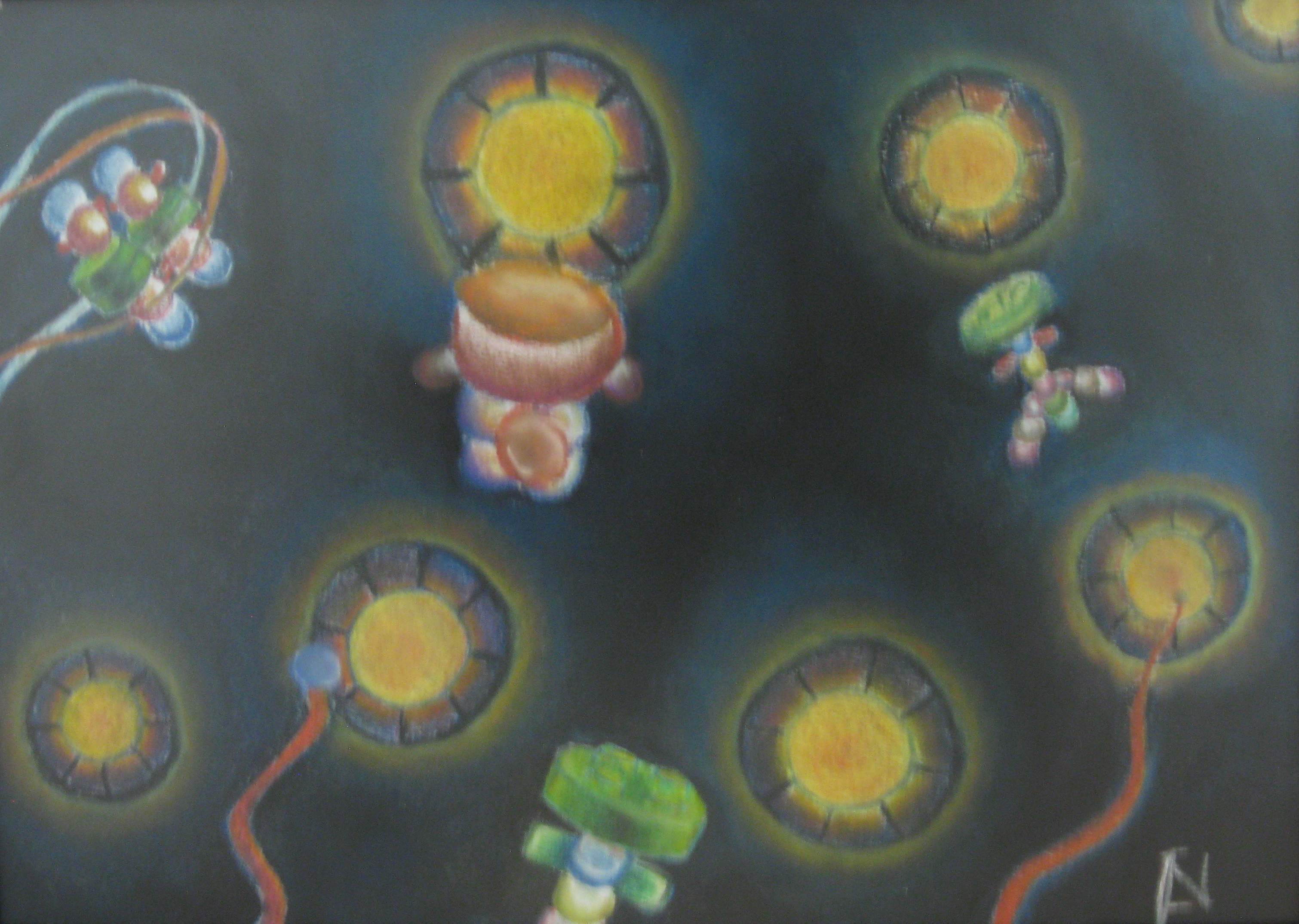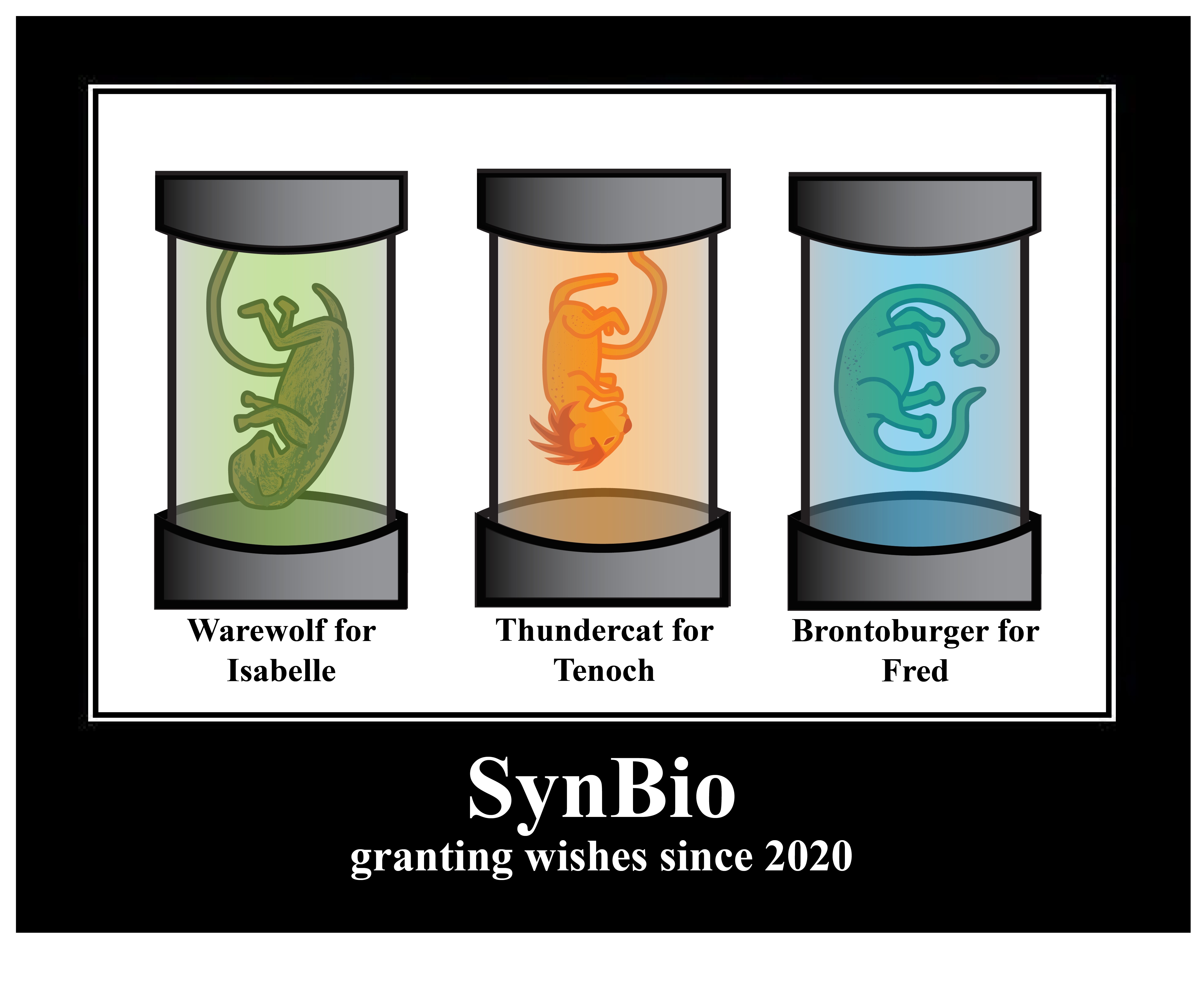Team:UNAM-Genomics Mexico/Bio-SintetizArte
From 2011.igem.org
{{:Team:UNAM-Genomics Mexico/Templates/Modeling| content=
Welcome to the page dedicated to the Bio-Sintetizarte art exposition.
Información en Español
- Para la información en español de esta página da click aquí.
- Para la convocatoria de Bio-SintetizArte da click aquí
ART is the universal language that permits us to express the invisible, the inexplicable, the intuitive, the inexistent. It presents itself as a way that helps us to diffuse the Synthetic Biology essence, but it goes beyond that, it takes place in this revolution when it transmits its message back to scientist and to the society.
Contents |
We are more than delighted to present you with this branch of our Human Practices. Bio-Sintetizaste is dedicated to collect the perception of the participant artists about Synthetic Biology. This activity is designed to, progressively and in an evergrowing fashion, convey some concepts of Synthetic Biology.
We called for the participation of local mexican artists to get creative and create some arte inspired by a reflection on Synthetic Biology. We also made the information on the topic available on a website and talk at the auditorium of our campus.
We managed to obtain the space for the exposition in the museum "Casa de la Ciencia"(House of Science) in Cuernavaca through the Cultural Diffucion Office of the University. The inauguration is programmed for September 30th 2011 and the it will be in exhibition in the temporary exhibition room of the museum until October 28th 2011.
With this temporary exhibition, where the description of the art pieces and the aspects of Synthetic Biology that led the artists to their creations will be featured, the diffusion of Synthetic Biology through attendance to the exposition will reach a high number of people.
The art is the universal language that permits us to express the invisible, the inexplicable, the intuitive, the inexistent. It presents itself as a way that helps us to diffuse the Synthetic Biology essence, but it goes beyond that, it takes place in this revolution when it transmits its message back to scientist and to the society.
The Relationship Between Art and Science
Looking back at the history of art we find that unlike the Platonic notion of art as imitation, where the work is valued and recognized by its resemblance to reality, it is today possible to work directly with that reality which used to be embodied on the canvas, namely it is no longer necessary to portray a social group or represent biological systems since it is feasible to work with society itself or to use these biological systems to create a piece of art.
In the postmodern era, artistic disciplines break the boundaries and expand further to form hybrids of art and technology, science or anthropology, fusions that stand out. It is important to emphasize that art is a reflection of the events that occur in society and of the thinking that takes place at different times in history.
For this project it was decided to convene scientists, artists and interested public to reflect on synthetic biology through various artistic expressions. The exhibition features paintings, graphics, video, sculpture and installation.
BiosintetizArte poses the diffusion of synthetic biology, and jointly with the visitor, a device is intended to be generated through the works, for the viewer to form his opinion, question and search more about the subject. This exhibition is expected to reach a broad audience of different ages, beliefs and professions.
While art gives rise to the creation within a plane or in space, synthetic biology gives rise to the creation or modification of living things that may or may not have a utility to humans.
Bio-sintetizarte
The main topic of this collective exposition is the Synthetic Biology, emergent research and development area that pretends to make ingeneering with biological systems in a simple manner. In essence, this new discipline has as its main pillars the design, the construction and the study of new functions and biological systems non existent in nature.
This temporal exposition gather together the work of different artists and scientists that have created a work of art from imagining and meditating about what Synthetic Biology is for them, its principles, its grasps, its benefits, its risks, its consequences and any feeling that awakes in them before the world of possibilities that offers this new and exciting field.
The spectator will take part of the presented works, as he will be able to inform and actively participate in the discussions and reflexions that surrounds the Synthetic Biology. He will be meeting with the possibilities and the reality of being able to intervene with the organisms and to modify them to achieve any scientific or technologic objective.
The art is the universal language that permits us to express the invisible, the inexplicable, the intuitive, the inexistent. It presents itself as a way that helps us to diffuse the Synthetic Biology essence, but it goes beyond that, it takes place in this revolution when it transmits its message to scientist and to the society.
The artists that participate are: Amira Olvera, Elias Xolocotzin, Francesca Dalla Benetta, Héctor F. Medina, Libertad Pantoja, Yuridia Tamayo, Jach, Karina E. Rojas Calderón and Daniel Cristoball / Daniel Ramírez.
The exposition took place thanks to the colaboration with the UNAM Genomic Sciences Undergraduate Programme, the Difussion and Extension Unit of the National Autonomous University of Mexico campus Morelos and the House of Science of the Autonomous University of the State of Morelos.
The Exposition
Art Work
In this section you will find a description of some of the art pieces in the expositon. These descriptions were written by authors themselves.
- Libertad Pantoja
- "Modulos" (Modules)
The molecules within the cell for groups denominated modules. These can be formed by only one or several molecule species and very diverse elements that work together to give place to determined structures or functions. The modularity, as a property that delimits a group of elements that relates them for a process so they can produce signals to communicate with other modules in the cell, has to be deeply understood to make the biosynthetic systems work in the expected manner, giving place to the expected products without intervening with the rest of the cell's machinery.
- Libertad Pantoja
- "Señales" (Signals)
Many of the signals that communicate in the microscopic world are not so different of the signals we use in our daily lives. They have their own code that allows them to be identified within the cell; eliminate messages when they are not necessary; or unite or combine elements that acquire different functions when they are together.
Within synthetic biology one can play with these codes. It is possible to create, add or modify signals inside the microorganisms with which it can be altered or create diverse functions. This piece represents the modification of the small molecular parts that are inserted in a cell to enter in contact with the DNA and through this change its functionality.
In this piece, such signals are represented as small parts of the molecules (In red) that allow them to enter into a cell compartment known as the nucleus; while the other portions (in green) are part of the factors that allow the external information with the DNA. The figures in the shape of the flower are the cell nucleus' pores: the barrier into which the molecules had to pass through and where the recognition happened before entering the nucleus. The orange ribbons are mRNA: signaling molecules that are the result of the communication between the external factors and the DNA.
- Héctor F. Medina
- "Criaturas del hombre" (Creatures of Men)
The point of the image is to showcase 3 elements. The first is a Warewolf, a creature engineered to please its owner. In this particular case, the being is simply a "ware" instead of a real Werewolf. As such, it is a commodity. It is supposed to fill in the perceived needs of the adolescent girl it's intended for: safety, security, dependency, loyalty, sex. It is supposed to merge the desirable traits of a wolf into a male body that exudes masculinity (through muscle, hair, & musk), while retaining the key elements of a humanized creature: accountability, intelligence, & resourcefulness. The Warewolf will not love the teenager, but it will what is expected of it, and through the deep desire to be "in the pack", will fall in line. It will respect the chain of command (i.e. the Father) as well as protect its charge from others (stereotypical teenage human males). Moreover, it will serve as emotional training ground for the teenage girl. Once the girl matures into viewing those attachments beyond "puppy love", the Warewolf will be worn into a pet. To prevent this, it dies, tragically fast (sudden telomerase failure), prompting the teenager to evaluate all emotional attachments as costly, and favoring an overprotective father's opinion that "no one is good enough for the little princess".
The second element is a Thundercat. This creature is meant to serve as a plaything / companion for prepubescent teenagers. It is supposed to be intelligent, crafty, independent, yet playful like a cat. It should not be dependent on the child, but it should support him/her or provide back up. It has much more lethal potential than the werewolf, yet it is much more controlled (think retractile claws). As such, it is the perfect companion for adventurous children. It will form strong attachments without showing them, and will seek the best for its charge. When not required, it will simply go amuse itself taunting the neighbor's dog or chasing a beaver... It will not require continuous attention, but will still appreciate it. Moreover, it serves as pest control. It lives for around 13 years, it's later 3 years characterized by a much more tranquil lifestyle (due to induced arthritis and increased bone density) that should correlate with the onset of adolescence and the "I don't care about the world" attitude. Then it dies, very fast. Sudden ribosomal failure.
The last element is a brontosaurus. Originally a black iguana, supersaurus inserts were introduced into the genome until a viable creature emerged. In the purest "Jurassic Park inspired me", this creature is a chimera favoring phenotipically an ancient dinosaur, yet with intrinsic and core modern reptile characteristics. The goal of this creature is to provide exotic meet to specialty-diners, without raising moral questions about re-introducing extinct animals to modern environments. Originally it was intended to go to a recreational audience in the hunting business, but resurrecting extinct creatures for sport was deemed "inhumane". Therefore they are being resurrected for food. A $10,000 burger, but food nonetheless. Every precaution is being taken with these creatures, as the alarmist media was quick to point out the dangers: through mutation, a harmless 100 ton herbivore could yield a super-deadly 10 pound carnivore such as a velociraptor in few generations. Thus, the creatures are: a) designed to be genetically sterile, b) they are chemically sterilized in vitro, c) they are surgically sterilized after birth, d) are kept in isolation their entire lives, e) their corpses are burned by rocket engines, f) and their remains sent to the Sun. "BrontoBurgers R' Us" was the first restaurant to open with these products, and it opened in the Culinary Capital of the world: Paris. Ironically, since the french are the most outraged by the brontoburgers, the restaurant's exclusive clientele is exclusively international.
- Amira Olivo Olvera
- Video: "Synthetic Biology"
From our nature to ask the reason of everything is that now we know and understand a lot of things about the world that surrounds us. And thanks to this understanding we have been able to control the surroundings to our benefits. However, in spite of the noted scientific and technological level that we have, there are still phenomena that are so complex that we can't fully understand or control them, in particular those regarding the living beings, in biology. In medicine we have seen a lot of breakthroughs in treatments, derived from a bigger knowledge and understanding of our organism, and also thanks to the advances in the technologies to treat diverse diseases and illnesses.
The doctors want to cure the patients of all the wounds, until they are not visible anymore. For that, the synthetic biology is presented as a great tool and a world of possibilities. We hope to see that this discipline, together with the advances in genetics, epigenetics and medicine, offers us the capacity to control our genetic information, modify the way we respond to the environment and personalized treatments.
- Elias Xolocotzin
- "Bacteria Sonora" (Sound Bacteria)
This piece makes an analysis about the created microorganisms, in this way it makes an allusion to synthetic biology. In this case the synthetically generated organism is an inexistent sound in nature, but at the same time it is originated from the modifications in the sound waves that travel in the air where it's combined with the sound frequencies of nature to generate a sound texture that is composed only by synthetic and nature sounds. This sound piece was developes during my internship at the Centro Mexicano para la Musica y las Artes Sonoras(CMMAS).
The objective is to be able to generate an autonomous sound environment, where the sounds that inhabit it can be developed or die, as it happens in the environments and the organisms in nature, taking as a reference for the experiment the Darwinean Theory of Natural Selection.
There are organisms that reproduce and the offspring inherits the progenitors characteristics, there are variations in the characteristics if the environment does not admit all the members of a growing population. Then the members with the less adapted characteristics (according to the environment) will most probably die. So the members with the better adapted characteristics will survive. Darwin, The Origin of Species based on the studies of natural selection by Darwin, I will develop the next sound project which will take into account the way in which the natural organisms are adapted to artificial organisms created by science and technology in such a way that the project will bring together analogous and digital elements and sounds in this new symbiosis between technology and nature.
- Daniel Cristobal / Daniel Ramírez
- Anîma ∞
Anîma ∞ is born out of the interest to localize the position in the genetic code that give rise to human souls. There were elements identified that code for a protein denominated Anîma ∞. Using the molecular tools of synthetic biology, this protein was expressed and a method was generated for the detection of the souls in the living beings that express the protein Anîma ∞. Based in these results, we want in the future to combine the expression of the protein Anîma ∞to the generation of bioluminiscence for a better detection of the Anîma ∞ expression.
- Francesca Dalla Benetta
- "Insectos-utero" (THE UTERUS-INSECTS)
The work I present on the occasion of the convening BIOsintetizARTE adheres to the second definition of synthetic biology: The redesign of biological systems o
 "
"



